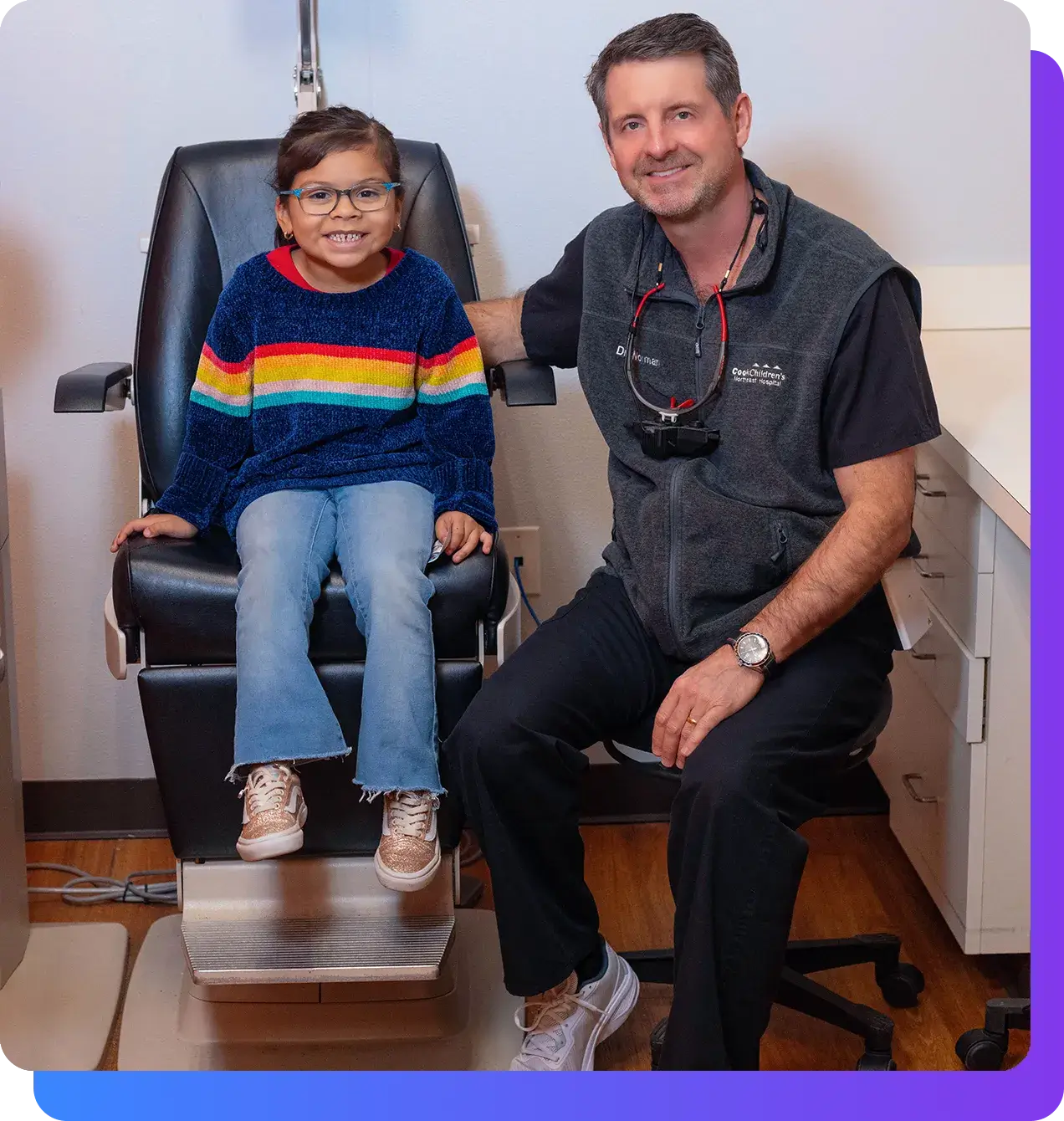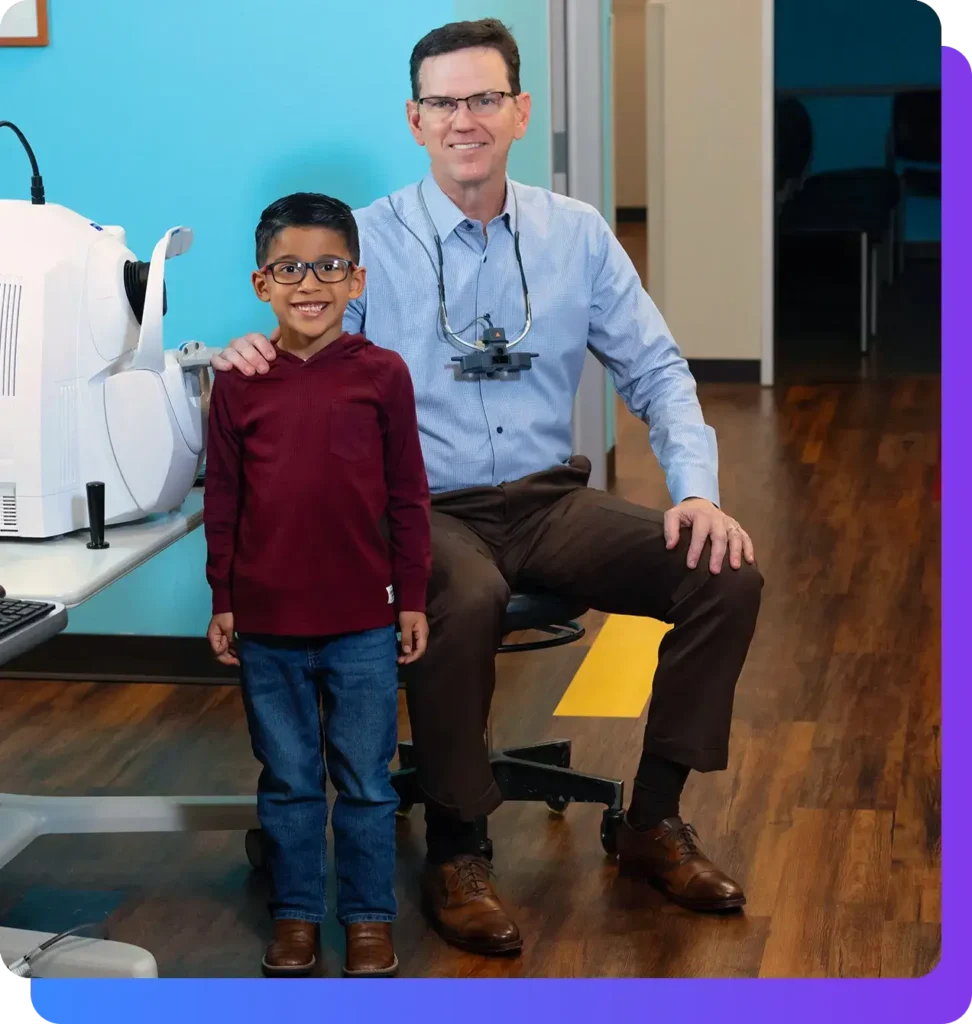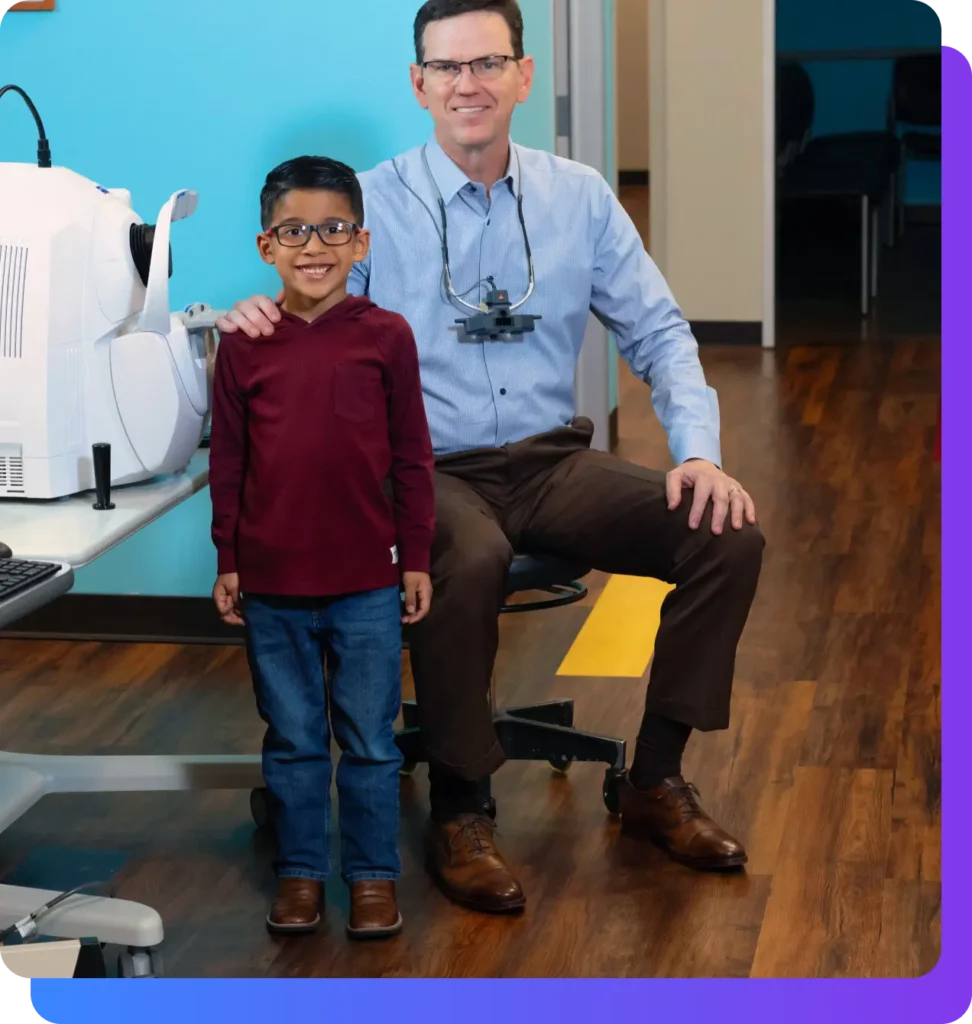Pediatric Chalazion and Styes
Specialists in North Texas
Discovering that your child has Pediatric Chalazion or Styes can be unsettling as a parent. You may feel unsure about how this condition could impact their vision and overall well-being, raising concerns about how to support their development, education, and future opportunities.
Expert Pediatric Chalazion and Styes Treatment for North Texas
At Pediatric Eye Specialists, we understand the concerns that come with a diagnosis of Pediatric Chalazion or Styes and are here to provide the clarity and support you need. Our team is dedicated to offering expert care and compassionate guidance throughout your child’s journey. Let’s discuss how these conditions can impact your child’s vision, the potential implications for their overall health and development, and the available treatment options. We are here to provide treatment, reassurance, and hope every step of the way.

The Basics: What are Pediatric Chalazion or Styes?
Pediatric chalazia and hordeolums, also called styes, are common eyelid conditions seen in children. At Pediatric Eye Specialists, we frequently treat chalazia, ensuring families have the right information and care for their child’s eye health. A stye is a painful, red bump that develops near the edge of the eyelid due to a bacterial infection in an oil gland or eyelash follicle. It can cause swelling, tenderness, and discomfort. A chalazion, on the other hand, is a painless lump that forms further back on the eyelid when an oil gland becomes blocked. While styes are painful and appear along the eyelid margin, chalazia are typically painless and take longer to develop. Both conditions are generally harmless and often resolve on their own with warm compresses, but if symptoms persist or worsen, Pediatric Eye Specialists is here to provide expert care and treatment.
Why Choose the Pediatric Eye Specialists for Your Child's Pediatric Chalazion and Styes
The Most Experienced Team in North Texas
With over sixty-five years of collective pediatric ophthalmology expertise, we offer your child unparalleled collaborative care.
Five Convenient Locations
Easily accessible care with offices in Fort Worth, Denton, Keller, Mansfield, and Prosper,
Unrushed, Clear Communication
We take the time to discuss your child's diagnosis and treatment, ensuring all your questions are answered to ease your concerns.
Affiliated with Cook Children’s Hospital
Our partnership with Cook Children’s Hospital means if your child needs surgery, imaging, or other specialists, they will be treated in one of the nation’s leading pediatric hospitals.
Specialized Expertise
Our expertise means that more optometrists, doctors, and specialists refer their pediatric eye patients to Pediatric Eye Specialists than any other pediatric eye practice in North Texas.
Child and Family Focused
Kids love us, and we love kids! We provide a caring environment for your child and your family.
Advanced Diagnostic Technology
We have the most comprehensive pediatric diagnostic suite in North Texas, allowing for precise diagnosis and highly personalized treatment plans.
Every Child Needs Access to Expert Eye Care
Championing the right to sight, we help navigate insurance, cash pay, and Medicaid options to make superior eye care feasible for all children regardless of their socioeconomic status.

The Benefits of Treating Pediatric Chalazion and Styes
Treating pediatric chalazion and styes early can improve your child’s comfort and reduce the risk of complications. Prompt care helps relieve symptoms, prevent recurrence, and support healthy eye development.
Success You Can Expect for Your Child
Faster Healing and Symptom Relief
Timely treatment of pediatric chalazion and styes can speed up healing, reducing swelling and discomfort more quickly than waiting for them to resolve on their own.
Prevention of Complications
Proper treatment can prevent complications such as infections that could spread or worsen. In some cases, untreated chalazia can grow large enough to press on the cornea, leading to temporary vision issues. Addressing these conditions early reduces the risk of additional eye problems.
Improved Vision and Eye Comfort
Large chalazia can interfere with a child's vision, making it difficult to see clearly. Treating them helps restore normal vision and eliminates discomfort caused by swelling or irritation. This ensures that children can focus on their daily activities without unnecessary visual disturbances.
Reduced Recurrence and Future Eye Health
Treatments like warm compresses, lid hygiene, and medical management help keep eyelid glands clear, lowering the chance of future chalazion or stye development. Establishing good eye care habits early can contribute to long-term eye health.
Avoidance of Surgery
While most chalazia and styes resolve without intervention, persistent or severe cases may require surgical removal. Early treatment can often prevent the need for more invasive procedures, which might otherwise require general anesthesia in young children.
Enhanced Confidence and Emotional Well-being
Visible eyelid bumps and swelling can affect a child’s confidence, especially in social settings. Effective treatment helps restore their normal appearance, allowing them to feel more comfortable and confident in their daily interactions.
Real Stories,
Real Smiles.
“They were very good with my nonverbal toddler. It was the best doctor visit experience we have had yet. They were awesome, caring, and quick!.”

Amy Glover
Parent of Patient
“Today, Dr. Packwood saved my youngest from a life of blindness and worked a miracle for my family. I cannot express enough gratitude and thanks for their skillful surgery and expertise. 10 of 10 highly recommend.”

Atticus Lee
Parent of Patient
“The staff here is so amazing with my son. We had such a wonderful experience both at the office and for his surgery! I highly recommend Pediatric Eye Specialists!!!!“

Gianna Stutzman
Parent of Patient
“We are so grateful for the genuine care that Dr. Duff provided for our son Lorenzo, which prevented him from going blind! She is truly a gift to the community.“

JS Cocjin
Parent of Patient
“Professional, compassionate, kind and friendly. They took great care of my preemie baby from Day 1 of ROP. Very happy with how my daughter is progressing and has healthy eyes now.”

Suresh K.C.
Parent of Patient
“We’ve seen Dr. Hunt for the past 6 years since my daughter was 9 days old. We have multiple appointments each year and even eye surgery when she was 1. Our experience here has been fantastic every time and we highly recommend this group!.”

Mandy Edmondson
Parent of Patient
“Dr. Norman has always been very attentive and thorough with my daughter, who has Type 1 Diabetes. The staff are warm and always do their best to be accommodating. I highly recommend Dr. Norman.”

Tricia Moon
Parent of Patient
“Absolutely recommend! All around great experience! They made my son feel comfortable during the visit. Treatment was explained, and I walked out with no questions. I loved it. “

Cynthia Valero
Parent of Patient
“Great staff, great doctors; they know how to help ease kids’ fears and provide excellent service. Had to get my little one in same day for an eye injury, and they found a way to make it happen. Would 100% recommend.“

Kris K
Parent of Patient
Start your child’s journey to better vision today.
Embrace a future of clearer vision and confidence for your child. Contact us now to book your consultation at any of our convenient locations across the Metroplex.
Click to Explore Pediatric Chalazion and Styes
Causes of Pediatric Chalazion and Styes
Pediatric chalazion and styes develop due to different underlying causes, though both involve issues with the eyelid glands.
A chalazion forms when the meibomian glands in the eyelid become blocked, preventing the normal flow of oil. Viral infections, certain skin conditions like seborrhea and acne rosacea, and poor eyelid hygiene can contribute to this blockage. Inflammation from allergies or other irritants can also interfere with gland function, increasing the likelihood of chalazion development.
A stye is usually caused by a bacterial infection, most often from Staphylococcus aureus, which affects the oil-producing or sweat glands in the eyelid. Blocked sebaceous glands, poor hygiene, and frequent eye rubbing can introduce bacteria and lead to infection. Children are particularly at risk due to exposure to contaminated surfaces, sharing personal items, and touching their eyes with unclean hands. A weakened immune system can also increase susceptibility to styes.
Certain conditions, such as seborrhea, rosacea, and chronic blepharitis, can contribute to both chalazion and stye formation, even though they are more common in adults. At Pediatric Eye Specialists, we help identify and manage these risk factors to support your child’s eye health.
Understanding these causes is vital for Pediatric Eye Specialists in diagnosing and formulating an effective treatment plan for Pediatric Chalazion and Styes.
Signs and Symptoms of Pediatric Chalazion and Styes
Identifying the signs and symptoms of pediatric chalazion and styes can help parents seek timely care for their child. Although these conditions have distinct characteristics, they can share some overlapping features.
Signs and Symptoms of Pediatric Chalazion
A small, painless bump or lump on the eyelid
Gradual swelling of the eyelid
Discomfort in the eye, especially if the chalazion grows large
Blurry vision in rare cases due to pressure on the cornea
Typically not painful
Signs and Symptoms of Pediatric Styes
Swelling of the eyelid
Redness along the edge of the eyelid
Localized pain and tenderness in the affected area
Drainage of yellow fluid (pus)
Itchiness of the eye and eyelid
Excessive tearing
While chalazia are usually painless and develop gradually, styes are more acute and often associated with pain and tenderness. Both conditions can cause discomfort and swelling, but styes tend to present with more noticeable and immediate symptoms. If these signs persist or worsen, consulting Pediatric Eye Specialists ensures your child receives expert care and appropriate treatment.
Still Have Questions?
Pediatric chalazion and styes can sometimes develop gradually, making regular pediatric eye examinations important for early identification. If you notice any of these signs or symptoms, consult a pediatric ophthalmologist for a thorough evaluation. Early diagnosis and treatment are essential for achieving the best outcomes for children with these eyelid conditions.
Diagnosing Pediatric Chalazion and Styes
Pediatric chalazion and styes are diagnosed through a clinical examination and a review of the child’s medical history. A pediatric ophthalmologist will assess the eyelid, symptoms, and potential risk factors to determine the appropriate diagnosis.
A chalazion is identified through a physical examination, where a healthcare provider looks for a painless, non-tender bump on the eyelid, typically less than 1 cm in size. The provider may ask about symptom duration, previous occurrences, and possible contributing factors. In some cases, the eyelid may be gently turned inside out to check for an internal chalazion. If the chalazion is large, a visual acuity assessment may be performed to determine if it is affecting vision.
A stye is diagnosed based on its appearance as a red, swollen, and tender bump near the eyelid margin. The provider will examine the lesion, noting whether it is firm or fluctuant if pus is present. Questions about symptom onset, pain level, and related conditions like blepharitis can help confirm the diagnosis. A visual acuity check may also be done to ensure the stye is not impacting vision.
While most cases do not require further testing, additional evaluations may be considered if chalazia or styes frequently recur or do not respond to standard treatments. This may include bacterial cultures to identify infections, blood tests to check for underlying conditions such as diabetes, or a biopsy in rare cases to rule out malignancies, particularly for persistent chalazia in the same location. At Pediatric Eye Specialists, we provide thorough evaluations to ensure an accurate diagnosis and appropriate treatment for each child’s needs.
Treatments for Pediatric Chalazion and Styes
Treating pediatric chalazion and styes typically starts with simple home care, but more advanced treatments may be needed if the condition does not improve.
For most children, warm compresses are the first step. Applying a warm, moist cloth to the eyelid for 1-2 minutes, several times a day, can help reduce swelling and encourage drainage. Microwavable warm packs can provide more prolonged warmth when applied to the eyelid. Keeping the eyelids clean with a gentle cleanser, such as diluted baby shampoo or an eyelid wipe, can also prevent future issues. If the eye feels irritated or dry, artificial tears may provide relief.
If the bump does not go away or signs of infection develop, a doctor may recommend antibiotic ointments or drops to help clear the infection. In some cases, oral antibiotics may be needed. For chalazia that do not go away on their own, steroid drops or an injection may help reduce inflammation.
If the chalazion or stye is large, painful, or does not improve with other treatments, a minor procedure may be necessary. This could involve a small incision to drain the lump or, in some cases, a steroid injection to shrink it.
Most chalazia and styes improve within a couple of weeks with simple treatments. However, if symptoms persist or worsen, it’s important to seek medical care. At Pediatric Eye Specialists, we provide expert care to help your child feel comfortable and recover as quickly as possible.
Our commitment at Pediatric Eye Specialists is to provide your child with the highest standard of care, combining medical expertise with compassion and understanding.
Typical Expected Outcomes for Pediatric Chalazion and Styes
Pediatric chalazion and styes generally heal well with proper care. Most styes go away within one to two weeks using warm compresses and good eyelid hygiene. If a stye is large or doesn’t improve, removal under brief sedation at Cook or another pediatric facility may be necessary. In some instances, the parents of older patients elect to have a minor procedure in the office.
Chalazia can take longer to go away, but many will resolve on their own within a few weeks. Warm compresses can help speed up the healing process. If a chalazion doesn’t go away, removal under brief sedation at Cook or another pediatric facility may be necessary. In some instances, the parents of older patients elect to have a minor procedure in the office.
The sooner treatment begins, the better the outcome. Keeping your child’s eyelids clean and following treatment recommendations can prevent future issues. Some children may be more prone to chalazion or styes, especially if they have conditions like blepharitis, but most cases clear up without causing long-term problems.
With the right care, your child’s eyelid will heal, and their eye will feel comfortable again. At Pediatric Eye Specialists, we are here to provide expert care and guidance to help your child recover quickly and comfortably.
Secure a Brighter Future: Schedule Your Child's Pediatric Chalazion and Styes Consultation Today
Don’t let Pediatric Chalazion or Styes affect your child’s bright future. Schedule an appointment with Pediatric Eye Specialists to provide your child with the expert care and treatment they need. Take the first step toward protecting their vision and unlocking a lifetime of possibilities—contact us today.

Start your child’s journey to better vision today.
Embrace a future of clearer vision and confidence for your child. Contact us now to book your consultation at any of our convenient locations across the Metroplex.
Can a chalazion or stye affect my child’s vision?
While chalazia and styes are generally harmless, a large chalazion can press on the eye and cause blurry vision. If you notice any changes in your child’s vision, it’s important to consult a pediatric ophthalmologist. At Pediatric Eye Specialists, we can assess your child’s condition and provide appropriate treatment to protect their vision.
Are chalazia or styes contagious?
Styes are caused by bacterial infections and can be contagious, especially if there is direct contact with the drainage. Chalazia, on the other hand, are not caused by infections and are not contagious. Encouraging your child to practice good hygiene, such as not touching or rubbing their eyes and washing their hands regularly, can help prevent the spread of infection. Pediatric Eye Specialists can provide guidance on proper eye care to minimize the risk of contagion.
When should I seek medical attention for my child’s chalazion or stye?
If your child’s chalazion or stye does not improve with home treatment after a few weeks, becomes increasingly painful, affects vision, or if the swelling spreads beyond the eyelid, it’s important to seek medical attention. At Pediatric Eye Specialists, we can evaluate your child’s condition and recommend appropriate treatment options to ensure a swift recovery.
Can chalazia or styes reoccur in children?
Yes, some children may experience recurrent chalazia or styes, especially if they have underlying conditions like blepharitis or skin conditions such as seborrheic dermatitis or rosacea. Maintaining good eyelid hygiene and addressing any underlying conditions can help reduce the likelihood of recurrence. The team at Pediatric Eye Specialists can provide personalized strategies to prevent future occurrences.
Is it safe to use over-the-counter treatments for my child’s stye or chalazion?
There are multiple OTC eyelid hygiene products available at pharmacies. Warm compresses are usually the first line of treatment. If the condition persists or worsens, it’s best to consult with Pediatric Eye Specialists for appropriate evaluation and treatment options tailored to your child’s needs.
Can allergies cause chalazia or styes in children?
Allergies can lead to eye rubbing and inflammation, which may increase the risk of developing chalazia or styes. Managing your child’s allergies and discouraging eye rubbing can help prevent these conditions. Pediatric Eye Specialists can offer advice on managing allergies to protect your child’s eye health.
Are there any long-term effects of chalazia or styes in children?
Most chalazia and styes resolve without long-term effects. However, if left untreated, a large chalazion can cause astigmatism due to pressure on the cornea, leading to blurred vision. Early treatment and monitoring by professionals at Pediatric Eye Specialists can prevent potential complications and ensure your child’s eyes remain healthy.
Can diet influence the development of chalazia or styes in children?
While no direct link has been established between diet and the development of chalazia or styes, a balanced diet supports overall health, including eye health. Ensuring your child has a nutritious diet and stays hydrated can contribute to their well-being. For personalized advice, consult the experts at Pediatric Eye Specialists.
Is surgery necessary for treating chalazia or styes in children?
Surgery is typically considered only when chalazia or styes do not respond to conservative treatments like warm compresses or medications. If the lump persists, grows, or affects vision, a minor surgical procedure may be recommended. The specialists at Pediatric Eye Specialists can assess your child’s condition and discuss the most appropriate treatment options.
How can I prevent my child from developing chalazia or styes?
Encouraging good eyelid hygiene is key to preventing chalazia and styes. Teach your child to wash their hands regularly, avoid touching or rubbing their eyes, and keep their face and eyelids clean. If your child has a history of these conditions, regular check-ups with Pediatric Eye Specialists can help monitor their eye health and prevent future issues.
Can eye drops or other medications help treat chalazia or styes in children?
In some cases, a doctor may prescribe eye drops or topical medication to help reduce inflammation or prevent infection, especially if the condition is persistent or severe. However, most chalazia and styes improve with warm compresses and proper eyelid hygiene. If your child’s symptoms do not improve or worsen, a specialist at Pediatric Eye Specialists can determine whether additional medicine is needed to promote healing.
Can chalazia or styes cause swelling beyond the eyelid?
While chalazia and styes are usually localized to the eyelid, severe cases can lead to edema, or swelling, that extends beyond the affected area. This can cause discomfort and, in rare cases, may indicate an underlying infection. If you notice significant swelling, redness, or warmth around your child’s eyelid, it’s important to seek medical attention. The team at Pediatric Eye Specialists can assess the severity and provide appropriate treatment to ensure your child’s eye remains healthy.
How do chalazia and styes affect a child’s vision?
Although chalazia and styes are typically minor conditions, a large or improperly treated bump can press on the human eye, leading to blurred vision. In some cases, this pressure can temporarily alter visual perception, making it harder for a child to see clearly. If your child complains of vision changes or difficulty focusing, a specialist at Pediatric Eye Specialists can evaluate their condition and provide the necessary care to restore their comfort and clarity.